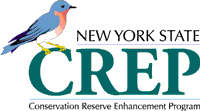AG - NYS Conservation Reserve Enhancement Program (CREP)


Farmers are now eligible to receive annual rental payments and other financial incentives for enrolling environmentally sensitive land within priority watersheds and public well-head areas in the New York State Conservation Reserve Enhancement Program, otherwise known as CREP. The CREP (pronounced “krep”) is a partnership between state and federal agencies designed to help farmers address agricultural related environmental concerns on 40,000 acres of land across the state. Participants voluntarily retire cropland or pastureland that is located on steep slopes or borders streams, creeks, lakes and public well-head areas to help reduce sediment and nutrient runoff from entering critical watersheds. Retiring highly erodible lands and planting it to native grasses, trees and other protective vegetation will enhance water quality and provide shelter, nesting areas and food for wildlife. In return for taking these environmentally sensitive lands out of production and placing them in the CREP for 10-15 year contract periods, producers are eligible to receive the following: annual rental payments, annual maintenance payments, cost-share assistance, practice incentive payments, a signing incentive payment, and possibly an annual tax credit. The CREP agreement between USDA and New York State was signed in October of 2003 and enrollment is continuous. In order to be eligible to enroll in the CREP, land must be located within the eligible watersheds of 12 major New York State basins or surrounding a public well-head. Additionally, cropland must have been cropped four of the six years between 2012 and 2017 and must be capable of being cropped in a normal manner today. Marginal pastureland is also eligible for enrollment, provided it is suitable for use as a grass, riparian or a wetland buffer practice. Creating buffers and establishing vegetative cover demonstrates agriculture’s commitment to the environment and the health of community neighbors. Producers wishing to learn more about enrolling land in the New York State CREP should contact the Wyoming County Soil and Water Conservation District (SWCD), Farm Service Agency (FSA) or Natural Resource Conservation Service (NRCS) office.
Frequently Asked Questions About CREP

1. What is the Conservation Reserve Enhancement Program?
The Conservation Reserve Enhancement Program or CREP (pronounced “krep”) is a federal and state conservation partnership designed to address agriculture-related environmental concerns. Participants receive financial incentives from USDA to voluntarily enroll environmentally sensitive cropland or pastureland in contracts for a period of 10 to 15 years. In return for annual rental payments and financial incentives, participants convert the land to native grasses, trees and other conservation vegetation
2. What are the environmental benefits of CREP?
The New York CREP will help farmers address erosion and nutrient runoff within New York’s high priority watersheds. CREP’s aim is to remove environmentally sensitive cropland planted on steep slopes or bordering streams, creeks and lakes. Retiring highly erodible cropland and planting it to protective vegetation will enhance water quality, while providing shelter, nesting areas and food for wildlife. Buffers planted along stream banks will filter phosphorus, nitrogen and sediment from runoff before it enters the waterways.
3. What areas in New York are included in the program?
CREP is available in specified watersheds throughout the state. Eligible watersheds were selected because the NYS Priority Waterbody List indicates that they are negatively impacted due to agricultural activities. USDA and NY State aim to place 40,000 of the most environmentally sensitive acres into the program. Public wellhead protection areas, as designated by the New York State Department of Health, are also eligible for enrollment within these watersheds. CREP will remove cropland acreage surrounding wellheads from crop production, thereby reducing the potential for contaminants to affect the water supply.
4. What are the goals of the New York CREP?
The goals of the New York CREP are: Reduce nutrient loading of * phosphorus from 145,284 pounds per year to 72,642 pounds per year * nitrogen from 77,376 pounds per year to 38,688 pounds per year * sediments from 175,316 tons per year to 70,126 tons per year. Reduce the potential for pathogens to enter identified waterbodies. Establish riparian buffers adjacent to 4,598 stream miles and 473,457 acres of surface waters. Establish conservation vegetation on areas that serve Environmental Protection Agency approved wellhead zones.
5. What type of cropland is eligible for CREP?
Eligible cropland must have been cropped four of the six years between 2012 and 2017. Additionally, the land must be physically and legally capable of being cropped in a normal manner. Marginal pastureland is also eligible for enrollment provided it is suitable for use as a buffer practice.
6. What conservation measures are applicable?
* Field boundaries and marginal pastureland adjacent to surface water are the primary focus of the program. These acres would be planted to grass or a combination of grasses, shrubs and trees. * Whole fields may be enrolled, but to qualify the slope of the acreage must meet certain highly erodible qualifications and 50 percent of the acreage must be within 1,000 feet of a surface water source. These fields may be planted to grasses, trees, wildlife habitats and/or wetlands. * Fields located in wellhead protection areas can be planted to grasses and trees as well.
7. What will producers earn under CREP?
New York CREP participants will be eligible for the following types of USDA payments: * Annual Rental Payments: all producers will receive an annual rental payment based on the soil’s pre-determined rental rate. This rate will then be increased by an additional 145 percent as an incentive to enroll in the program (Example: A $40 rental rate plus the 145% incentive payment ($58) equals a $98/acre annual rental payment.). Annual rental payments are issued in October. * Annual Maintenance Payment: To offset any cost incurred by the producer for preserving the conservation practice, a maintenance payment of $2 to $10 dollars per acre will be added into the annual rental payment on buffer practices. * Cost-Share Assistance: USDA will reimburse farmers up to 50 percent of the eligible costs for installing conservation practices. * Practice Incentive Payment: As an incentive to establish certain practices, a one-time payment equal to 40 percent of the installation cost will be issued. This payment is in addition to the cost-share assistance and issued upon completion of the practice. * Signing Incentive Payment: Eligible producers will also receive a one-time payment of up to $100 per acre for land enrolled in a grass waterway, riparian buffer, filter strip, upland wildlife habitat buffer or wetland buffer practice. This payment is made after the contract has been signed and approved. In addition, New York will offer: * An annual tax credit: CREP acres may be added to the first 250 acres of qualified agricultural land eligible for a New York State income tax credit to offset school taxes. Cost-Share Assistance: Producers may be eligible to receive additional cost-share assistance through New York State on a competitive basis.
8. Are there other benefits to enrolling in CREP?
Establishment of riparian buffers and other CREP practices is a visible way to demonstrate your commitment to environmental stewardship. Neighbors and community members often notice and appreciate these efforts toward protecting water quality and wildlife. Participation in CREP can also help ensure a safe drinking water supply for your livestock by reducing contaminants entering surface water. If livestock are fenced out of streams altogether, an alternate water supply may be installed to provide fresh drinking water.
9. When will CREP sign-up begin?
The CREP agreement between USDA and New York State was signed on October 29, 2003. Enrollment will be on a continuous basis. Each CREP contract is for a 10 to 15 year period. Farmers and landowners can enroll at their local Farm Service Agency office or the Soil and Water Conservation District office.
10. Where can I get more information about the program?
More information on the New York CREP is available from local Soil and Water Conservation District, Natural Resource Conservation Service or Farm Service Agency offices and on FSA’s Web site at: [url=https://www.fsa.usda.gov/programs-and-services/conservation-programs/conservation-reserve-program/index]https://www.fsa.usda.gov/programs-and-services/conservation-programs/conservation-reserve-program/index[/url]. NYS CREP is a partnership between: United States Department of Agriculture New York State Soil & Water Conservation Committee and New York State Department of Agriculture & Markets